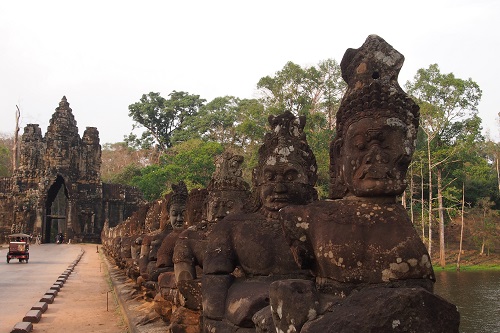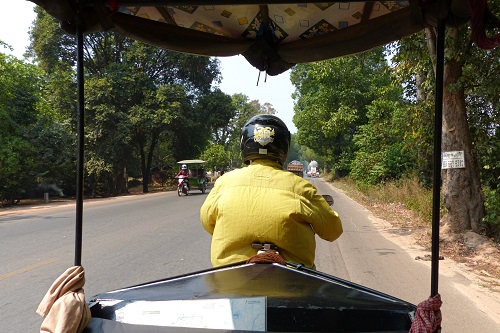“If your bike is going to fall apart, it's going to do it soon.” I joked cheerfully. We were just leaving Ta Nei, the tiniest, most overgrown and least touristy of the Angkor temples we visited. Cycling down a sandy dirt track, we were all too aware that we were 17km from our guesthouse in Siem Reap. More importantly, this was our turnaround point and the furthest away we would be from town that day. If anything was going to go wrong, this would be the most inconvenient place for it to happen. Not two minutes later, there was a clunk as a pedal fell off one of our rental bikes. Cycling around the Angkor temples was great fun but if we did it again, we'd be better prepared.

Ta Nei Temple
Solution 1: Continue Cycling Around The Angkor Temples Without A Pedal
Our first thought was whether we could keep cycling, just relying on the one remaining pedal. That didn't work. It turns out the pedals are linked so once one had fallen off, the other soon followed.
Solution 2: Fix The Rental Bike
Our next idea was to try and fix it. Sadly, when preparing for 3 months in Southeast Asia it had never even occurred to us to pack a tool kit.
We made it to the nearest temple, which thankfully wasn't very far. The usual horde of tuk-tuks was parked outside, the drivers chatting or snoozing while they waited for their customers to return. We asked around, hoping in vain that a tool kit might be standard equipment for a tuk-tuk driver. Apparently not. One produced a pair of pliers and we used them to improvise with the contents of our backpacks. We made a rough tool from a butchered keyring and a cable tie. Feeling very proud of our A-team effort, we then tried to reattach the pedal.

The Road To Angkor Thom
Our success was limited. The pedal had obviously come off before and there had been liberal use of a hammer in the repairs. Even with the correct tools, fixing this mangled mess would have been difficult. We did manage to get the pedal at least partly attached and set off again. However, just a few minutes later, there came a familiar thunk and we were back to square one.
Solution 3: Find Another Way Back To Siem Reap
We tried again and again to reattach the pedal, and eventually made it to the Bayon, one of the most iconic of the Angkor temples. While standing at the roadside debating whether it would be faster to walk, a tuk-tuk pulled up alongside us. Out of habit, when we were first offered a lift, we declined. Not the most sensible response, given the circumstances, and we quickly changed our minds. We manhandled our bikes into the carriage, with wheels hanging out both sides of the vehicle. We just managed to fit ourselves in as well, contorting our legs in all directions. Drawing a few curious stares, we started the uncomfortable but much appreciated journey back to Siem Reap.

The Bayon
Returning with a broken bike, the man at the bike rental shop was extremely apologetic. He didn't seem too bothered that his bike needed repairing though. Neither did he seem surprised. We got the impression this may happen more often that you'd think.
Lesson 1: Always Check A Rental Bike
Learning from the man in the bike shop, we checked over our rental bikes every morning before we headed out to the temples. They can fix most problems at the shop, or find a more suitable bike for you. Once you're out on the road, it gets more difficult. Obviously it didn't help in this case but we did avoid a whole host of other problems.
Our Rental Bike Checklist
1. Check the bike is a suitable height and adjust the position of the saddle if necessary.
2. Feel the tyres and make sure they're firm. You don't want to be cycling around with a flat.
3. Lift one end of the bike and try to spin the wheel. If the wheel is buckled, it won't spin for long. Check both wheels.
4. Have a quick cycle around. Check the bike cycles smoothly and that you can change the gears up and down.
5. Make sure the brakes work.
Learning from our experience cycling around the Angkor temples, we may also add in a pedal check next time.

View Cycling Past Sras Srang
Lesson 2: Carry A Bike Rescue Kit
At home, we always carry a few essentials when we're out on our bikes. In hindsight, this would have been really useful in Siem Reap too. At a minimum, take a bike multi-tool, mini bike pump and a puncture repair kit. They shouldn't take up too much space in your rucksack.
Hiring A Bike In Siem Reap
We found a few bike rental shops on BBU Road near the roundabout with Sivutha Blvd. The different shops had different types of bikes on offer and we chose one that offered mountain bikes. While there was some variation in price, all of the shops were very cheap. It was just a few US dollars to rent a bike for a day.
Most of the roads around the Angkor temples are paved and in reasonable condition, which makes cycling very easy. A mountain bike is by no means a necessity. However, a few of the smaller temples, like Ta Nei, are only accessible by dirt track. If you intend to visit these places, you may find a mountain bike useful.

Roadside Statues At Angkor Thom
On the days we cycled around the Angkor temples, we arrived at the bike shop around 7am. There was a good selection of bikes available at this time. We were asked to leave photo ID at the shop while we had the bikes. We didn't want to leave our passports in their care but they seemed happy enough with our PADI dive instructor cards. These would have been easily replaced had we lost them.
Tips For Cycling Around The Angkor Temples
The saddles on the bikes we hired were rock hard and sitting on them got fairly uncomfortable. Our backsides couldn't cope with two consecutive days of cycling. Unless you bring a cushion, you may prefer to cycle on some days and take a tuk-tuk on others.
It can get very hot in Cambodia so bring plenty of water with you. There are stalls at most of the bigger temples that sell drinks and snacks if you need them.
To see the main highlights of the Angkor temples in a short time, most people opt for either the 'Small Circuit' (approx. 28km round trip) or the slightly longer 'Grand Circuit' (approx. 38km round trip). Both of these are within reasonable cycling distance from Siem Reap. Banteay Srei is much further (approx. 80km round trip). If you plan to visit this temple, take a tuk-tuk.
The temple complex at Roluos is a 30km round trip from Siem Reap. This is mainly cycling along a busy highway so you may be more comfortable in a tuk-tuk.

The Road To Roluos
Getting A Ticket For The Angkor Temples
1. On your first day, before you enter the Angkor Archaeological Park, you will need to buy a temple pass from the official booth. There is only one ticket booth and it's not on the main road between Siem Reap and the temples. You'll have to take a detour. Look for the Angkor Park Pass Ticket Counters on Google Maps. It's also worth noting that many maps still show the old ticket office but this is no longer in use.
2. Buy a temple pass for 1, 3 or 7 days.
3. Each morning, before you enter the temple complex, get your pass stamped at one of the checkpoints. You will need to do this on your first day too. There are checkpoints on most of the bigger roads to the temples.
4. You will still need to show the pass at the entrance to each temple as well.
